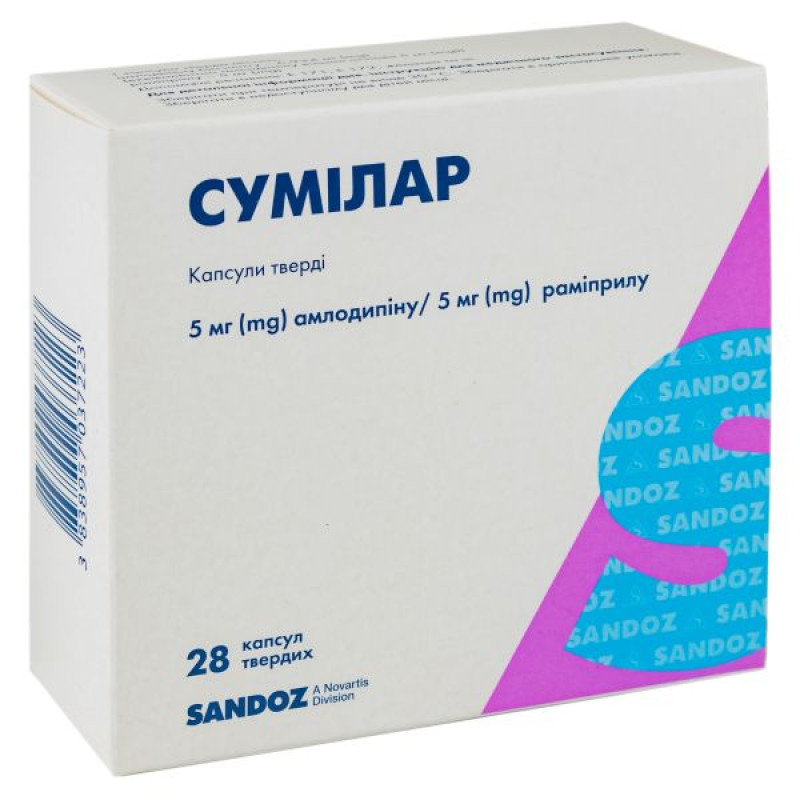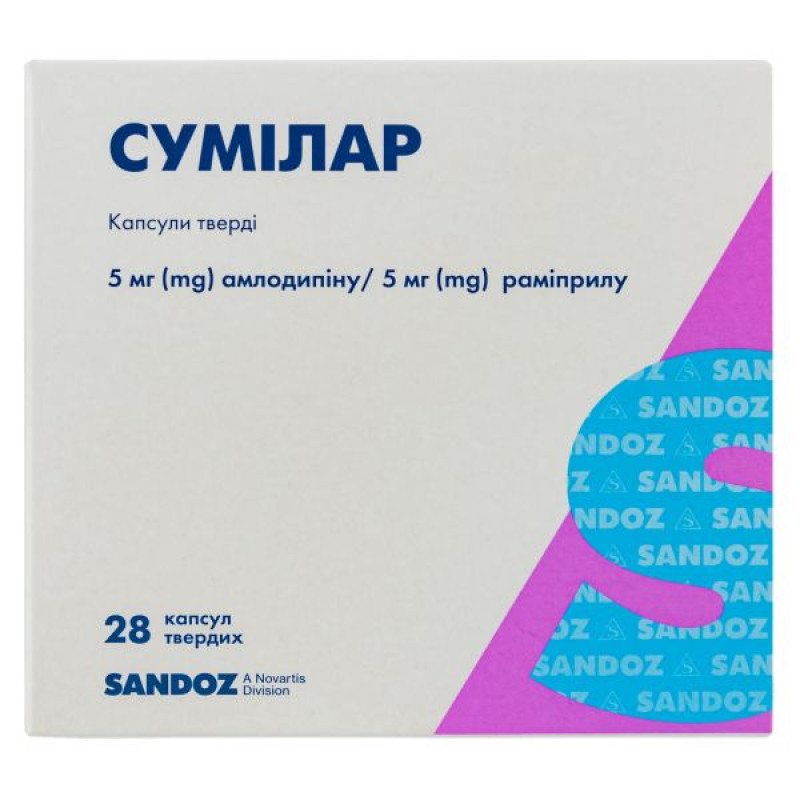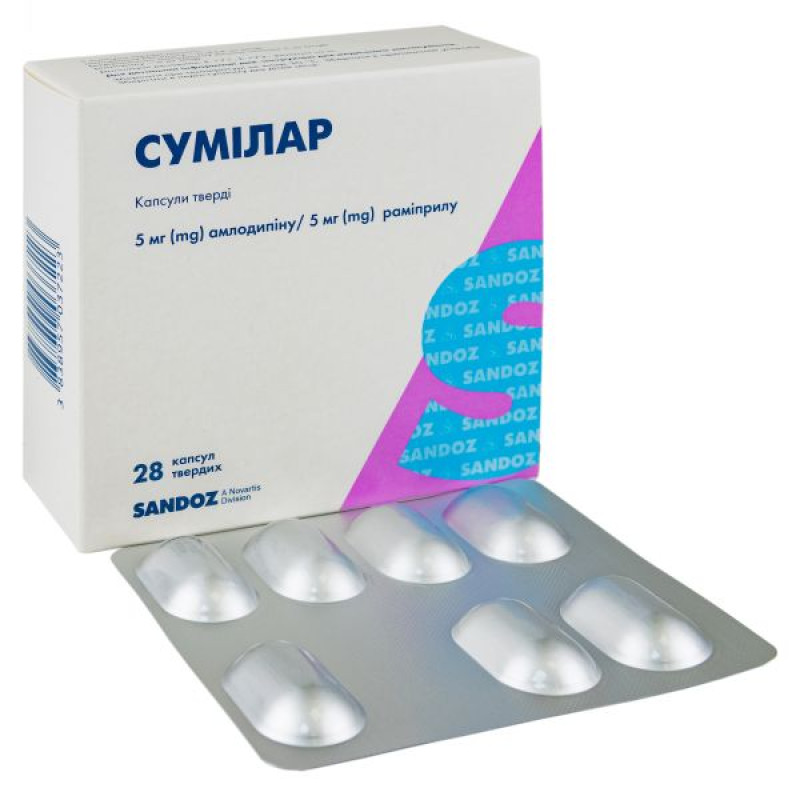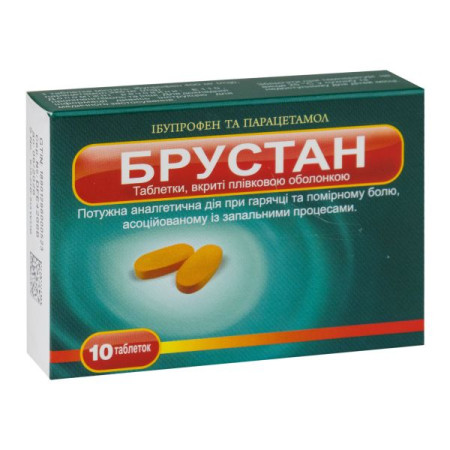Sumilar hard capsules 5 mg + 5 mg blister No. 28

Instructions for Sumilar hard capsules 5 mg + 5 mg blister No. 28
Composition
active ingredient: amlodipine besylate, ramipril;
1 hard capsule contains:
5 mg/5 mg: 6.934 mg amlodipine besylate equivalent to 5 mg amlodipine free base and
5 mg ramipril or
10 mg/10 mg: 13.868 mg amlodipine besylate equivalent to 10 mg amlodipine free base and
10 mg ramipril or
10 mg/5 mg: 13.868 mg amlodipine besylate equivalent to 10 mg amlodipine free base and
5 mg ramipril or
5 mg/10 mg: 6.934 mg amlodipine besylate equivalent to 5 mg amlodipine free base and
10 mg ramipril;
excipients:
capsule contents: microcrystalline cellulose, calcium hydrogen phosphate anhydrous, pregelatinized corn starch, low moisture pregelatinized corn starch, sodium starch glycolate (type A), sodium stearyl fumarate;
capsule shell 10 mg/5 mg; 5 mg/5 mg; 5 mg/10 mg: titanium dioxide (E 171), gelatin, red iron oxide (E 172);
capsule shell 10 mg/10 mg: yellow iron oxide (E 172), red iron oxide (E 172), black iron oxide (E 172), titanium dioxide (E 171), gelatin.
Dosage form
The capsules are hard.
Main physicochemical properties:
Hard capsules 5 mg/5 mg: hard gelatin capsules, size No. 1, opaque pink cap, opaque white body, capsule contents – white or almost white powder.
Hard capsules 10 mg/10 mg: hard gelatin capsules size No. 1, opaque brown cap, opaque white body, capsule contents – white or almost white powder.
Hard capsules 10 mg/5 mg: hard gelatin capsules size No. 1, opaque red-brown cap, opaque white body, capsule contents – white or almost white powder.
Hard capsules 5 mg/10 mg: hard gelatin capsules, size No. 1, opaque dark pink cap, opaque white body, capsule contents – white or almost white powder.
Pharmacotherapeutic group
Combined preparations of ACE inhibitors. ACE inhibitors in combination with calcium antagonists. Ramipril and amlodipine. ATC code C09B B07.
Pharmacological properties
Pharmacodynamics.
Mechanism of action of ramipril
Ramiprilat, the active metabolite of ramipril, inhibits the enzyme dipeptidylcarboxypeptidase I (synonyms: angiotensin-converting enzyme, kininase II), which catalyzes the conversion of angiotensin I by tissues to the active vasoconstrictor angiotensin II, as well as the breakdown of the active vasodilator bradykinin. A decrease in the amount of angiotensin II and inhibition of the breakdown of bradykinin causes vasodilation.
Since angiotensin II also stimulates aldosterone release, ramiprilat leads to a decrease in aldosterone release. On average, the response to ACE inhibitor monotherapy was less in black (Afro-Caribbean) hypertensive patients (usually in the low-renin hypertension category) than in other races.
Pharmacodynamic effects
The use of ramipril causes a pronounced decrease in peripheral arterial resistance. Usually, no significant changes in renal plasma flow rate and glomerular filtration rate are observed. In patients with arterial hypertension, ramipril reduces blood pressure both in the supine and standing positions, without increasing heart rate.
In most patients, the antihypertensive effect begins 1-2 hours after administration of the drug, reaches a maximum after 3-6 hours and lasts for 24 hours.
The maximum reduction in blood pressure is usually achieved after 3-4 weeks of continuous treatment. The antihypertensive effect has been shown to be maintained during long-term therapy for up to 2 years.
Abrupt withdrawal of ramipril does not lead to a rapid and excessive reactive increase in blood pressure.
Mechanism of action of amlodipine
Amlodipine inhibits the transmembrane influx of calcium ions into the smooth muscles of the heart and blood vessels (slow channel blocker or calcium ion antagonist).
The mechanism of the antihypertensive action of the drug is due to a relaxing effect on vascular smooth muscle.
The exact mechanism of action of amlodipine in angina has not been established, but it is known that the drug reduces myocardial ischemia in two ways:
1. Amlodipine dilates peripheral arterioles and as a result of the work of the heart reduces total peripheral resistance. Since the heart rate is practically unchanged, the reduction in the load on the heart causes a decrease in myocardial oxygen demand.
2. By dilating the main coronary arteries and coronary arterioles in both intact and ischemic areas of the myocardium, it improves oxygen delivery. By this mechanism, it increases oxygen delivery to the myocardium even in cases of coronary artery spasm (Prinzmetal's angina or variant angina).
Pharmacological properties
In patients with angina, once-daily dosing increases total exercise time, time to angina onset, and time to significant ST-segment depression, and reduces both the frequency of angina attacks and the need for glyceryl trinitrate.
The drug is not associated with any adverse metabolic effects: it had no effect on plasma lipid levels, blood sugar levels, and serum uric acid levels. The drug is acceptable for use in patients with asthma.
Pharmacokinetics
Ramipril
Absorption
Ramipril is rapidly absorbed after oral administration: maximum plasma concentrations are reached within 1 hour. Based on urinary excretion data, the extent of absorption is at least 56%; food intake does not affect the absorption of amlodipine. The bioavailability of the active metabolite, ramiprilat, after oral administration of 2.5 mg and 5 mg of ramipril is 45%.
The maximum plasma concentration of ramiprilat, the only active metabolite of ramipril, is reached 2-4 hours after administration of ramipril. Steady-state plasma concentrations of ramiprilat are reached after the usual doses of ramipril administered once daily on approximately the 4th day of treatment.
Distribution
The binding of ramipril to serum proteins is approximately 73% and that of ramiprilat is approximately 56%.
Metabolism
Ramipril is almost completely metabolized to ramiprilat and to diketopiperazine ester, diketopiperazine acid, glucuronides of ramipril and ramiprilat.
Breeding
Metabolites are excreted mainly by the kidneys.
Ramiprilat plasma concentrations decline in several phases. Due to strong binding to ACE and slow dissociation from the enzyme, ramiprilat is characterized by a prolonged terminal elimination phase with very low plasma concentrations.
After once-daily administration of ramipril, the effective half-life of ramiprilat was 13–17 h for doses of 5–10 mg and was longer for doses of 1.25–2.5 mg. This difference is due to the ability of the enzyme to bind ramiprilat in a saturable manner.
Patients with renal insufficiency
Renal excretion of ramiprilat is reduced in patients with impaired renal function, and renal elimination of ramiprilat is proportional to creatinine clearance. This results in increased plasma concentrations of ramiprilat, which decrease more slowly than in patients with normal renal function.
Patients with hepatic insufficiency
In patients with impaired liver function, the metabolism of ramipril to ramiprilat was slowed down due to reduced activity of hepatic esterases. Ramipril plasma levels were increased in these patients. The maximum concentration of ramiprilat in these patients, however, did not differ from that in patients with normal liver function.
Amlodipine
Absorption
Amlodipine is well absorbed after oral administration. Peak blood levels are reached 6–12 hours after dosing. Its bioavailability is independent of food intake. Absolute bioavailability is 64–80%.
Distribution
The volume of distribution of the drug is approximately 20 l/kg. Steady-state plasma concentrations (5–15 ng/ml) are achieved after 7–8 days of consecutive once-daily dosing. In vitro studies have shown that 93–98% of circulating amlodipine is bound to plasma proteins.
Metabolism and excretion
Amlodipine is extensively metabolized (approximately 90%) in the liver to inactive pyridine derivatives. 10% of the parent compound and 60% of inactive metabolites are excreted in the urine, 20–25% in the feces.
The decline in plasma concentrations is biphasic. The terminal plasma half-life is approximately 35–50 hours, consistent with once-daily dosing.
The total clearance is 7 ml/min/kg (for patients weighing 60 kg - 25 l/h). In elderly patients this figure is 19 l/h.
Use in elderly patients
The time to reach maximum plasma concentrations of amlodipine is similar in elderly and younger patients. Clearance of amlodipine is usually somewhat reduced, which in elderly patients leads to an increase in the area under the concentration-time curve (AUC) and half-life of the drug. The increase in AUC and half-life in patients with congestive heart failure was consistent with that expected for this age group of patients (see section "Special instructions").
Patients with renal impairment
Amlodipine is extensively biotransformed to inactive metabolites. 10% of amlodipine is excreted unchanged in the urine. Changes in plasma concentrations of amlodipine do not correlate with the degree of renal impairment. Patients with renal impairment can use the usual doses of amlodipine. Amlodipine is not dialyzable.
Patients with liver dysfunction
The half-life of amlodipine is longer in patients with impaired liver function.
Indication
Treatment of hypertension in patients whose blood pressure is adequately controlled with individual drugs administered simultaneously at the same dose as in the combination, but as separate tablets.
Contraindication
History of angioedema (hereditary, idiopathic or previous angioedema while taking ACE inhibitors or angiotensin II receptor antagonists).
Extracorporeal treatment that results in blood coming into contact with negatively charged surfaces.
Significant bilateral renal artery stenosis or renal artery stenosis of a single functioning kidney.
Pregnancy or planning a pregnancy.
Hypotensive or hemodynamically unstable conditions.
Severe hypotension.
Shock (including cardiogenic shock).
Obstruction of the outflow tract from the left ventricle (e.g. severe aortic stenosis).
Hemodynamically unstable heart failure after acute myocardial infarction.
Childhood.
Hypersensitivity to amlodipine, dihydropyridine derivatives, ramipril or any other ACE (angiotensin-converting enzyme) inhibitors, or to any of the excipients of the drug.
Concomitant use with sacubitril/valsartan increases the risk of angioedema. Amlodipine/ramipril should not be used earlier than 36 hours after administration of sacubitril/valsartan (see sections 4.4 and 4.5).
Interaction with other medicinal products and other types of interactions
Regarding ramipril
Dual blockade of the renin-angiotensin system (RAS) with ACE inhibitors (angiotensin-converting enzyme inhibitors), ARBs (angiotensin receptor blockers), or aliskiren.
Concomitant use of ACE inhibitors, including ramipril, or ARBs with aliskiren is contraindicated in patients with severe or moderate renal impairment (GFR < 60 mL/min/1.73 m2).
Contraindicated combinations
The use of Sumilar in combination with aliskiren-containing products is contraindicated in patients with diabetes mellitus or moderate or severe renal impairment (GFR < 60 mL/min/1.73 m2) and is not recommended in other patients.
Extracorporeal therapies that bring blood into contact with negatively charged surfaces, such as dialysis or hemofiltration using certain high-flux membranes (e.g., polyacrylonitrile membranes) and LDL apheresis with dextran sulfate, are contraindicated because of the increased risk of severe anaphylactoid reactions. In such cases, consideration should be given to using a different type of dialysis membrane or a different class of antihypertensive drug.
Concomitant use of ACE inhibitors with sacubitril/valsartan is contraindicated due to an increased risk of angioedema (see sections 4.3 and 4.4). Ramipril treatment should only be initiated 36 hours after the last dose of sacubitril/valsartan. Sacubitril/valsartan treatment should only be initiated 36 hours after the last dose of ramipril.
Medicines that increase the risk of angioedema
Clinical studies indicate that dual blockade of the renin-angiotensin-aldosterone system (RAAS) with ACE inhibitors, angiotensin II receptor antagonists or aliskiren is associated with an increased incidence of hypotension, hyperkalemia and worsening of liver function (including acute liver failure) compared with monotherapy. It is recommended to monitor blood pressure, renal function and electrolytes in patients taking ramipril and other agents that affect the RAS.
Precautions for use
Potassium-sparing diuretics, potassium supplements, or potassium-containing salt substitutes
Although serum potassium levels are usually within normal limits, hyperkalaemia may occur in some patients treated with ramipril. Potassium-sparing diuretics (e.g. spironolactone, triamterene or amiloride), potassium supplements or potassium-containing salt substitutes may lead to significant increases in serum potassium. Concomitant use of ramipril with other medicinal products that increase serum potassium levels, such as trimethoprim and co-trimoxazole (trimethoprim/sulfamethoxazole), is not recommended, as trimethoprim, like amiloride, is known to act as a potassium-sparing diuretic. An increased risk of hyperkalaemia has been observed in patients receiving concomitant ACE inhibitors and trimethoprim or its fixed combination with co-trimoxazole (trimethoprim/sulfamethoxazole). If concomitant administration cannot be avoided, the drugs should be administered with caution and with frequent monitoring of serum potassium levels.
Antihypertensive agents (e.g. diuretics) and other substances that may lower blood pressure (e.g. nitrates, tricyclic antidepressants, anaesthetics, large amounts of ethanol, baclofen, alfuzosin, doxazosin, prazosin, tamsulosin, terazosin). An increased risk of arterial hypotension should be expected (for information on diuretics, see section "Method of administration and dosage").
Vasopressor sympathomimetics and other substances (e.g. isoproterenol, dobutamine, dopamine, epinephrine) that may reduce the antihypertensive effect of ramipril. Monitoring of blood pressure is recommended.
Allopurinol, immunosuppressants, corticosteroids, procainamide, cytostatics and other substances that may alter blood cell counts. Increased likelihood of hematological reactions.
Lithium salts: ACE inhibitors may decrease lithium excretion, which may lead to increased lithium concentrations and toxicity. Monitoring of lithium levels is necessary.
Antidiabetic agents, including insulin. Hypoglycemic reactions are possible. Monitoring of blood glucose levels is recommended.
Non-steroidal anti-inflammatory drugs and acetylsalicylic acid: A reduction in the antihypertensive effect of ramipril is to be expected. In addition, the concomitant use of ACE inhibitors and non-steroidal anti-inflammatory drugs (NSAIDs) may lead to an increased risk of deterioration of renal function and potassium levels.
Co-trimoxazole (trimethoprim/sulfamethoxazole)
Patients taking co-trimoxazole (trimethoprim/sulfamethoxazole) concomitantly may be at increased risk of developing hyperkalemia.
An increased incidence of hyperkalemia has been observed in patients taking ACE inhibitors and trimethoprim.
Medicines that increase the risk of angioedema
Concomitant use of ramipril with sacubitril/valsartan is contraindicated as it may increase the risk of angioedema. Sacubitril/valsartan should not be started earlier than 36 hours after the last dose of ramipril. If treatment with sacubitril/valsartan is discontinued, ramipril therapy should not be started earlier than 36 hours after the last dose of sacubitril/valsartan.
Concomitant use of NEP inhibitors (e.g. racecadotril), mTOR inhibitors (e.g. sirolimus, everolimus, temsirolimus), vildagliptin and ACE inhibitors may increase the risk of angioedema. Such medicinal products should be prescribed with caution after initiation of therapy.
Regarding amlodipine
Effects of other drugs on amlodipine
CYP3A4 inhibitors: Concomitant use of amlodipine with strong or moderate CYP3A4 inhibitors (protease inhibitors, azole antifungals, macrolide antibiotics such as erythromycin or clarithromycin, verapamil or diltiazem) may result in a significant increase in amlodipine exposure. The clinical significance of these pharmacokinetic variations may be more pronounced in elderly patients. Patients receiving clarithromycin in combination with amlodipine are at increased risk of hypotension.
Close monitoring of patients is recommended when amlodipine is administered concomitantly with clarithromycin.
Therefore, clinical monitoring and dose adjustment may be necessary.
CYP3A4 inducers: Concomitant use of known CYP3A4 inducers may reduce plasma concentrations of amlodipine. Therefore, blood pressure should be monitored and the dose adjusted if necessary during and after combination therapy, especially with strong CYP3A4 inducers (e.g. rifampicin, St. John's wort).
Amlodipine should be administered with caution with CYP3A4 inducers.
Grapefruit or grapefruit juice. Taking amlodipine with grapefruit or grapefruit juice is not recommended as bioavailability may be increased in some patients, leading to increased blood pressure lowering effects.
Dantrolene (infusion). Fatal ventricular fibrillation and cardiovascular collapse (sometimes fatal) have been observed in animals in association with hyperkalemia following verapamil and intravenous dantrolene. Because of the risk of hyperkalemia, it is recommended that concomitant use of calcium channel blockers such as amlodipine be avoided in patients at risk for malignant hyperthermia and in the treatment of malignant hyperthermia.
Effect of amlodipine on other medicinal products
Medicinal products with antihypertensive properties. The hypotensive effect of amlodipine potentiates the hypotensive effect of other antihypertensive agents.
Atorvastatin, digoxin, warfarin or cyclosporine: Clinical drug interaction studies have shown that amlodipine does not affect the pharmacokinetics of atorvastatin, digoxin, warfarin and cyclosporine.
Simvastatin: Coadministration of multiple doses of 10 mg amlodipine with 80 mg simvastatin resulted in a 77% increase in simvastatin exposure compared to simvastatin alone. In patients receiving amlodipine, the dose of simvastatin should be limited to 20 mg daily.
Tacrolimus
There is a risk of increased blood levels of tacrolimus when used concomitantly with amlodipine. To avoid tacrolimus toxicity, regular monitoring of tacrolimus blood levels and, if necessary, dosage adjustment is required when amlodipine is used concomitantly.
No interaction studies have been conducted with ciclosporin and amlodipine in healthy volunteers or other populations, except in renal transplant patients, where a variable increase in ciclosporin trough concentrations (mean 0-40%) was observed. In renal transplant patients receiving amlodipine, monitoring of ciclosporin concentrations should be considered and, if necessary, a reduction in the ciclosporin dose should be considered.
mTOR inhibitors
mTOR inhibitors such as sirolimus, temsirolimus, and everolimus are substrates of CYP3A.
Amlodipine is a weak inhibitor of CYP3A.
When used simultaneously with mTOR inhibitors, amlodipine may increase the effects of the latter.
Application features
Ramipril
Dual blockade of the renin-angiotensin-aldosterone system (RAAS)
Dual blockade of the RAAS by combining Sumilar with aliskiren is not recommended because there is an increased risk of hypotension and hyperkalemia and changes in renal function. The use of Sumilar in combination with aliskiren is contraindicated in patients with diabetes mellitus or renal insufficiency (GFR < 60 ml/min/1.73 m2).
Patients at particular risk of hypotension
Patients with hyperactivated renin-angiotensin-aldosterone system
Patients with a hyperactivated renin-angiotensin-aldosterone system are at risk of an acute pronounced fall in blood pressure and deterioration of renal function due to ACE inhibition, especially when an ACE inhibitor or concomitant diuretic is used for the first time or at the first dose increase.
Significant activation of the renin-angiotensin-aldosterone system should be expected and medical supervision, including blood pressure monitoring, should be instituted if the patient has:
severe hypertension;
decompensated congestive heart failure;
hemodynamically significant obstruction of inflow and outflow from the left ventricle (aortic or mitral valve stenosis);
unilateral renal artery stenosis with a second functioning kidney;
liver cirrhosis and/or ascites;
existing or potential dehydration and/or salt depletion (including patients taking diuretics);
having undergone serious surgery or during anesthesia with substances that cause arterial hypotension;
transient or persistent heart failure;
after myocardial infarction;
risk of cardiac or cerebral ischemia in case of acute hypotension;
elderly
It is recommended to correct dehydration, hypovolemia or excessive salt loss before starting treatment (however, in patients with heart failure, the possibility of carrying out such corrective measures should be carefully weighed against the risk of volume overload).
The initial stage of treatment requires special medical supervision.
Operations
It is recommended that treatment with angiotensin-converting enzyme inhibitors, such as ramipril, be discontinued one day before surgery, if possible.
Monitoring renal function
Renal function should be assessed before initiation, during treatment and when dose adjustments are made, especially in the first weeks of treatment. Particularly careful monitoring is required in patients with impaired renal function. There is a risk of deterioration of renal function, especially in patients with congestive heart failure or after kidney transplantation.
Hypersensitivity/angioedema
Angioedema has been reported in patients taking ACE inhibitors, including ramipril.
If angioedema occurs, ramipril should be discontinued.
Concomitant use of ramipril with sacubitril/valsartan is contraindicated as it may increase the risk of angioedema. Sacubitril/valsartan should not be started earlier than 36 hours after the last dose of ramipril. If treatment with sacubitril/valsartan is discontinued, ramipril should not be started earlier than 36 hours after the last dose of sacubitril/valsartan.
Concomitant use of ACE inhibitors and racecadotril, mTOR inhibitors (e.g. sirolimus, everolimus, temsirolimus) and vildagliptin may increase the risk of angioedema (e.g. swelling of the airways or tongue with or without respiratory distress).
For patients already receiving an ACE inhibitor, caution is required when prescribing racecadotril, mTOR inhibitors (e.g. sirolimus, everolimus, temsirolimus) and vildagliptin.
If angioedema develops, ramipril should be discontinued immediately. Emergency measures should be taken immediately. The patient should be monitored for at least 12-24 hours and may be discharged only after complete resolution of symptoms.
Intestinal angioedema has been reported in patients taking ACE inhibitors, including ramipril. These patients have experienced abdominal pain (with or without nausea or vomiting).
Anaphylactic reactions during desensitization
Electrolyte monitoring: hyperkalemia
Hyperkalemia has been observed in some patients taking ACE inhibitors, including ramipril. ACE inhibitors may cause hyperkalemia by inhibiting aldosterone release.
Patients at risk of hyperkalaemia include patients with renal insufficiency, elderly patients (> 70 years), patients with uncontrolled diabetes mellitus or those taking potassium salts, potassium-sparing diuretics and other active substances that increase plasma potassium levels (e.g. heparin, trimethoprim, co-trimoxazole, also known as trimethoprim/sulfamethoxazole, and especially aldosterone antagonists or angiotensin receptor antagonists), or those with conditions such as dehydration, acute cardiac decompensation, metabolic acidosis. If concomitant use of the above-mentioned agents is necessary, regular monitoring of serum potassium levels is recommended. Patients receiving ACE inhibitors should be treated with caution with potassium-sparing diuretics and angiotensin receptor antagonists, and blood potassium levels and renal function should be monitored.
Concomitant use of ACE inhibitors with sacubitril/valsartan is contraindicated due to an increased risk of angioedema (see sections 4.3 and 4.4). Ramipril treatment should only be initiated 36 hours after the last dose of sacubitril/valsartan. Sacubitril/valsartan treatment should only be initiated 36 hours after the last dose of ramipril.
Electrolyte monitoring: hyponatremia
In some patients treated with ramipril, a syndrome of inappropriate antidiuretic hormone secretion with subsequent development of hyponatremia has been observed. It is recommended that serum sodium levels be monitored regularly in the elderly and in other patients at risk of developing hyponatremia.
Neutropenia/agranulocytosis
Neutropenia/agranulocytosis, as well as thrombocytopenia and anemia have been reported rarely, and bone marrow depression has also been reported. Monitoring of white blood cell counts is recommended to detect possible leukopenia. More frequent monitoring is recommended at the beginning of treatment or in case of impaired renal function, concomitant collagen diseases (e.g. lupus erythematosus or scleroderma) or concomitant use of other medicinal products that may cause changes in the blood picture.
Racial differences
ACE inhibitors cause angioedema more frequently in black patients than in non-blacks. As with other ACE inhibitors, ramipril may be less effective in lowering blood pressure in black patients than in non-blacks, possibly because of a higher prevalence of a low-renin state in these hypertensive patients.
Cough
Cough has been reported with the use of ACE inhibitors. Typically, it has been described as non-productive, persistent, and resolving after discontinuation of treatment. In the differential diagnosis of cough, it should be considered that cough may be caused by treatment with ACE inhibitors.
Amlodipine
The safety and efficacy of amlodipine in hypertensive crisis have not been established.
Patients with heart failure.
Patients with heart failure should be treated with caution. In a long-term, placebo-controlled study in patients with severe heart failure (New York Heart Association class III and IV), a higher incidence of pulmonary edema was reported in the amlodipine group than in the placebo group. Calcium channel blockers, particularly amlodipine, should be prescribed with caution in patients with congestive heart failure because they may increase the risk of future cardiovascular events and mortality.
Patients with hepatic impairment
In patients with hepatic impairment, the half-life of amlodipine is prolonged and AUC values are higher, however
No dose adjustment recommendations are provided.
Amlodipine should be used with caution at doses at the lower end of the dosing range, both at the beginning of treatment and when increasing the dose.
Patients with impaired liver function may require a slow dose increase and close monitoring.
Use in elderly patients.
In elderly patients, the dose should be increased cautiously.
Use in renal failure.
Amlodipine can be used in such patients at usual doses. Changes in plasma concentrations of amlodipine are not related to the degree of renal insufficiency. Amlodipine is not dialyzable.
ACE inhibitors may cause hyperkalemia because they inhibit aldosterone release. The effect is generally minor in patients with normal renal function. However, in patients with impaired renal function and/or in patients taking potassium supplements (including salt substitutes), potassium-sparing diuretics, trimethoprim or co-trimoxazole, also known as trimethoprim/sulfamethoxazole, and especially aldosterone antagonists or angiotensin receptor blockers, hyperkalemia may develop. Potassium-sparing diuretics and angiotensin receptor blockers should be used with caution in patients receiving ACE inhibitors, and serum potassium and renal function should be monitored in such patients.
Special warnings regarding excipients
This medicine contains less than 1 mmol sodium (23 mg) per capsule, i.e. essentially ‘sodium-free’.
Use during pregnancy or breastfeeding
Pregnancy.
Ramipril.
Ramipril is contraindicated during pregnancy. ACE inhibitors may cause fetal or neonatal morbidity and mortality when used by pregnant women.
Use of ACE inhibitors during the second and third trimesters of pregnancy has been associated with fetal and neonatal harm, including hypotension, skull hypoplasia in the newborn, anuria, reversible or irreversible renal failure, and fatalities. Oligohydramnios has also been reported, presumably due to impaired fetal renal function; oligohydramnios in this setting has been associated with fetal limb contractures, craniofacial deformity, and hypoplastic lung development. Prematurity, intrauterine growth retardation, and patent ductus arteriosus have also been reported, although it is unclear whether these are caused by ACE inhibitors. In addition, use of ACE inhibitors during the first trimester of pregnancy is associated with a potentially increased risk of congenital malformations.
If pregnancy is confirmed, ACE inhibitors should be discontinued as soon as possible and regular fetal monitoring should be performed. ACE inhibitors (including ramipril) should not be used in women planning pregnancy. Women of childbearing potential should be informed of the potential risk and ACE inhibitors (including ramipril) should only be prescribed after careful counseling and consideration of the individual risks and benefits.
The drug is contraindicated for use in pregnant women or women planning to become pregnant. If pregnancy is detected during therapy, the drug should be discontinued immediately and, if necessary, replaced with another drug approved for use in pregnant women (see section "Contraindications").
Breastfeeding: If treatment is necessary, breastfeeding should be discontinued.
Fertility: Reversible biochemical changes in the sperm head have been reported in some patients receiving calcium channel blockers. There is insufficient clinical information regarding the potential effect of amlodipine on fertility.
Ability to influence reaction speed when driving vehicles or other mechanisms
Sumilar may have minor or moderate influence on the ability to drive and use machines. Some undesirable effects (e.g. symptoms of low blood pressure such as dizziness, headache, fatigue or nausea) may adversely affect the patient's ability to concentrate and react, and therefore pose a risk in situations where this ability is particularly important (driving and using machines).
This may occur, in particular, at the beginning of treatment or when switching from other drugs.
Caution is recommended, especially at the beginning of treatment and when changing the dosage.
Method of administration and doses
Doses
The recommended daily dose is one capsule.
Sumilar should be taken once a day, at the same time of day, with or without food. The capsules should not be chewed or crushed.
Fixed combination is not acceptable for initial t
There are no reviews for this product.
There are no reviews for this product, be the first to leave your review.
No questions about this product, be the first and ask your question.


















